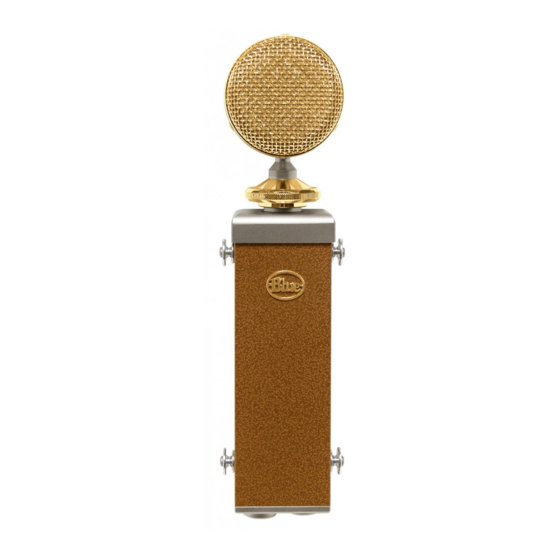Blue Cactus Manuel de l'utilisateur - Page 5
Parcourez en ligne ou téléchargez le pdf Manuel de l'utilisateur pour {nom_de_la_catégorie} Blue Cactus. Blue Cactus 6 pages. Blue microphones cactus microphones: supplementary guide
Également pour Blue Cactus : Manuel de l'utilisateur (9 pages)

Saxophones and Reeds
The smooth high end response and large diaphragm warmth of the
Cactus B7 capsule makes it an ideal candidate for miking saxophones
and other reed instruments. For soprano sax, clarinet and related
instruments, position the mic about a foot away, directly above
and in front of the keys between the middle of the horn and the
lowest pads. Try rotating the capsule or moving the mic up or down
along the length of the body to adjust the balance of airy highs
(toward the mouthpiece) and cutting midrange (toward the bell).
For other members of the saxophone family, start by placing the
capsule two to six inches in front of the lip of the bell. Turn the
capsule up toward the mouthpiece, or raise the microphone above
the bell to capture more air, brightness, and high notes. For a mel-
lower sound, rotating the microphone toward the floor emphasizes
the low range of the sax, and tames the biting upper mids that
project straight out of the bell, particularly on alto saxophone.
Brass
All members of the brass family need to be miked from in front
of the bell. But for studio recording it is not necessary to aim
the microphone capsule right down the center of the bore, or
place it too close. The trumpet, with its directional characteristics,
high sound pressure level, and limited frequency range, will yield
a clear, cutting tone at distances ranging from 6 inches to 2 feet.
The trombone and tuba can be approached similarly, although
closer miking toward the outer edge of the bell (4 to 8 inches),
and the enhanced proximity effect of supercardioid and figure of
eight pickup patterns will help offset a thin or overly bright timbre.
Capturing a mellow, rounded tone is a challenge with any brass in-
strument. To avoid buzzy highs and transient overloading, persuade
the player to blow at less than peak stage volume. Cornet and
flugelhorn usually have a softer, more intimate sound, are played
at lower volume, and can be miked at a distance of 2 to 6 inches.
Drums
The superior SPL capability, high end detail, and fast transient
response of the BLUE B7 capsule presents numerous advantages
when recording drums. For kit and hand drums, begin by posi-
tioning the capsule two to four inches above the rim or hoop
(where the head is secured to the shell). Angle the capsule toward
the player's stick or hand to pick up more attack and definition.
Turning the capsule toward the shell will soften the sharp attack
of a hand drum, or pick up more of the bright, crackling buzz from
a snare. Moving the microphone closer to a drum generally increases
the low end, shell resonance, and separation from other sound
sources, while more distant placement emphasizes the interaction
of the drum and the environment, producing a blended, airier sound.
The Cactus will produce an interesting personality when used at
a distance of four feet or more as an ambient room mic on drums.
Many modern pop recordings (as well as classic jazz, blues, and
R&B sessions) have benefited from the unique sound of minimalist
drum miking, where one to three microphones are strategically
placed to capture the entire set, along with the characteristics
of a well-tuned studio room.
Percussion
On tambourine, shaker, bells, clave, and orchestral percussion the
Cactus offers astounding clarity and realism, and can be positioned
quite close to a percussive source without distortion or undue
proximity effect. Start by placing the Cactus about a foot from
percussive instruments. Selecting a cardioid pickup pattern, or
moving the mic closer to the source will emphasize detail and
tone, as well as decreasing the proportion of ambient room sound
on a track. More distant placement, or the use of an omnidirec-
tional or figure of eight pattern will yield a natural, roomy sound
that blends easily with other rhythm instruments.
The Technical Page
The Cactus vacuum tube amplifier consists of a classic common
cathode circuit. The amplified signal is taken from the plate and
fed through a high-quality polypropylene capacitor, then output
to our BLUE custom hand-built transformer. The capacitor has a
low dielectric absorption coefficient and a low equivalent series
resistance. These parameters are essential to high end audio, and
are not present in lower priced microphones.
Inside the Cactus
